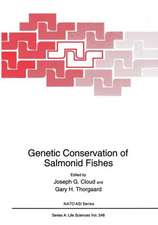Genes, Development and Cancer: The Life and Work of Edward B. Lewis
Editat de Howard D. Lipshitzen Limba Engleză Paperback – 21 noi 2012
- Papers are organized into sections that reflect the focus of the research
- Commentaries by Howard Lipshitz highlight key methods and results by explaining the science so it is accessible to upper-level undergraduates, graduate students, and professional researchers
| Toate formatele și edițiile | Preț | Express |
|---|---|---|
| Paperback (2) | 741.51 lei 6-8 săpt. | |
| SPRINGER NETHERLANDS – 12 oct 2007 | 741.51 lei 6-8 săpt. | |
| Springer Us – 21 noi 2012 | 1109.44 lei 6-8 săpt. | |
| Hardback (1) | 1123.13 lei 6-8 săpt. | |
| Springer Us – 30 ian 2004 | 1123.13 lei 6-8 săpt. |
Preț: 1109.44 lei
Preț vechi: 1167.83 lei
-5% Nou
Puncte Express: 1664
Preț estimativ în valută:
212.36€ • 230.75$ • 178.50£
212.36€ • 230.75$ • 178.50£
Carte tipărită la comandă
Livrare economică 21 aprilie-05 mai
Preluare comenzi: 021 569.72.76
Specificații
ISBN-13: 9781461347460
ISBN-10: 1461347467
Pagini: 576
Ilustrații: XVI, 557 p.
Dimensiuni: 155 x 235 x 30 mm
Greutate: 0.79 kg
Ediția:Softcover reprint of the original 1st ed. 2004
Editura: Springer Us
Colecția Springer
Locul publicării:New York, NY, United States
ISBN-10: 1461347467
Pagini: 576
Ilustrații: XVI, 557 p.
Dimensiuni: 155 x 235 x 30 mm
Greutate: 0.79 kg
Ediția:Softcover reprint of the original 1st ed. 2004
Editura: Springer Us
Colecția Springer
Locul publicării:New York, NY, United States
Public țintă
ResearchDescriere
While Edward B. (‘Ed’) Lewis is famous for his contributions to genetics anddev- opmental biology y, few have read his research papers. One reason for this is availability, man ny having been published in obscure journalsor as book chapters. A second is because his papers in those ?elds are very dif?cult to read. The dif?culty derives from the fact that Lewis has published infrequently, thus manypapers are condensed reviews of man nyyears’ work presented largely in summary form rather than in detail. It is not unusual for the reader to have to infer the experimental methods, even the results, from a few sentences. Furthermore, he often presents his results in terms of abstract models; thus it can be dif?cult to separate the data from the models. Ama ajor goal of this book is to make Lewis’ keypapers accessible to researchers and students. The papers are grouped into several sections that re?ect the changing focus of his research. Each section is preceded by commentary designed to place the papers in historical perspective, with respect to Lewis’ own ideas as well as to those of the larger scienti?c community. The commentaries attempt to highlight the key methods and results—as well as the signi?cance—of each paper by explaining the science in terms that should be understandable to upper-level undergraduates, graduate students and professional researchers.
Cuprins
Background -Invention of the cis-trans test for position effects -Position pseudoalleles -The bithorax pseudoalleles and the concept of developmental control -Gene evolution by tandem duplication -From cisvection to transvection- Extending the bithorax pseudoallelic series -Genetic versus functional models -From genes to gene complexes -Developmental genetics -Gain-of-function and loss-of-function alleles, and the operon model -Genetic mosaics: spatial and temporal aspects of bithorax function -The 1978 paper: a paradigm for the genetic control of development -Trans-acting regulators: positive and negative control of the homeotic complexes -Cis-regulation within the BX-C: the rules of engagement -Positional cloning of the BX-C -Completing the bithorax mutant series -The molecular basis of developmental control -Bithorax and the evolution of sexually dimorphic traits -DNA sequence motifs in the cis-regulatory regions of the BX-C -Evolution of the HOX complexes -Genetic and somatic effects of ionizing radiation -The political and social context -Leukemia and ionizing radiation -Political fallout -Thyroid radiation doses from weapons fallout -Best estimates of risk: leukemia in populations exposed to low doses of radiation -Estimates of lung cancer risk: the Batelle beagles
Caracteristici
Provides source material for advanced undergraduate and graduate level courses in genetics, developmental biology, radiation and cancer.
In addition, historians of science will find it to be a valuable resource both because it contains original research publications and because of the illuminating commentary
In addition, historians of science will find it to be a valuable resource both because it contains original research publications and because of the illuminating commentary
Recenzii
“A great book that is of interest to many geneticists, developmental biologists, and historians of science.” (Prof. Matthew P. Scott - Stanford University)
“A wonderful compendium of Lewis' papers. Lipshitz has done an outstanding job of summarizing – and in many cases clarifying – Lewis' writings.” (Prof. James F. Crow, University of Wisconsin, Madison)
“A very valuable reference for those studying developmental biology, radiation and cancer.” (Dr. Susan Celniker, Lawrence Berkeley National Laboratory, Berkeley, California)
“An excellent resource for understanding the emergence of developmental genetics.” (Prof. Siegfried Roth, University of Köln, Germany)
“Since the best way to become a good scientist is to understand how scientific ideas have been born and have developed, this book should be read by all graduate students in the areas of genetics, development and evolution.” (Prof. Markus Noll, University of Zurich, Switzerland)
“A wonderful compendium of Lewis' papers. Lipshitz has done an outstanding job of summarizing – and in many cases clarifying – Lewis' writings.” (Prof. James F. Crow, University of Wisconsin, Madison)
“A very valuable reference for those studying developmental biology, radiation and cancer.” (Dr. Susan Celniker, Lawrence Berkeley National Laboratory, Berkeley, California)
“An excellent resource for understanding the emergence of developmental genetics.” (Prof. Siegfried Roth, University of Köln, Germany)
“Since the best way to become a good scientist is to understand how scientific ideas have been born and have developed, this book should be read by all graduate students in the areas of genetics, development and evolution.” (Prof. Markus Noll, University of Zurich, Switzerland)
























